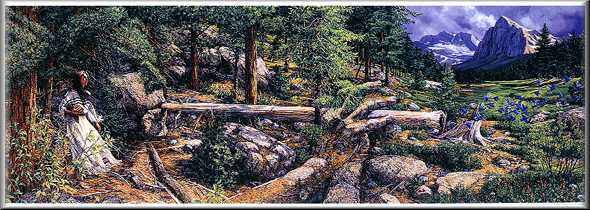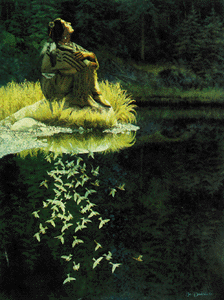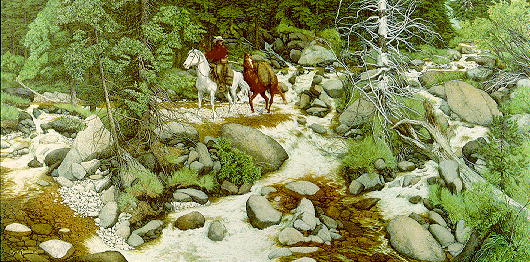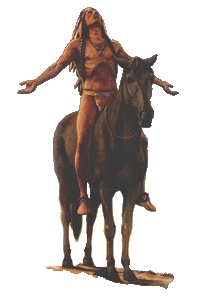













On May 4, 1999, the new golden one-dollar coin design was announced by the White House. The obverse, by Glenna Goodacre, depicts Sacajawea, the young Shoshone woman, in three-quarter profile. In the Shoshone verbal legend, Sacajawea is described as having large dark eyes, a feature included in this portrait relief. On her back she carries Jean Baptiste, her infant son, whom she carried and cared for on the 3,000 mile Lewis and Clark expedition.


The reverse, by Thomas D. Rogers, Sr., presents our nation's symbol, a soaring American bald eagle, encircled by 17 stars representing the states of the union at the time of the 1804 Lewis and Clark expedition. The new coin went into distribution in March, 2000. Please see the US Mint site at Mint for further information on Sacajawea and the new coin.

One of my favorite Indian artists is Bev Doolittle...here are samples of her paintings. See her two books, "The Art of Bev Doolittle, Text and Poems" by Elise Maclay ($65.00) and "New Magic" ($30.00). One of America's foremost artists, she is credited for "camouflage painting", as she is known for hiding people and animals.


 "The Forest Has Eyes"
"The Forest Has Eyes"At first glance, this might appear to be a trick painting, but look carefully again, for her works convey other messages. Here we read the story of a mountain man, not easily frightened but respectful of the ways of the Indians. Passing through Indian territory, he is wary. He is also alone far too long; that is when his imagination takes over, creating images and persuading us they are real. His eyes play tricks. Does the forest have eyes?
 "The Season of the Eagle"
"The Season of the Eagle"






Three Indians, riding into a remote canyon through a narrow passage, fasten their gaze on something high in the sky, which seems cut off from us as viewers. The artist tells us to look down instead of up to see a golden eagle, the good omen.

Doolittle explains, "In the life of the Native American, every new day, every encounter with bird or beast, and everything he owned or wore, related to his religious belief that all creatures were the creation of the same great power, and therefore were brothers."


This mountain man senses he has intruded on sacred Indian land. He feels watched and threatened. His horse plunges forward, anxious to get away.

 "Two Indian Horses"
"Two Indian Horses"


The forest and the mirror on the birch tree now tell a new story. As the mountain man enjoys a quiet early morning and cooks his bacon for breakfast, unexpected guests are about to make their presence known. Look carefully and you will see them!

